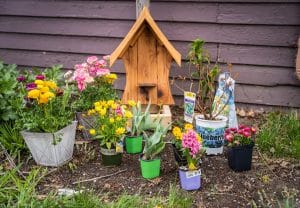Thus after the winter the spring will come, with its flowers, and you will hear the voice of the turtle-dove in this land. – Song of Songs 2:12
The ice has thawed. Sleds and winter boots are packed away and dusty bikes and trikes are being brought out of storage. Tiny buds are popping and blooming and robins are busily nesting. Children’s knees are already getting scraped, their fingernails dirty, and we’re reacquainting ourselves with neighbors we may not have seen for six months.
As we look around us, we see the signs of spring, of the world seeming to explode with the message of Easter—redemptive suffering and victory over death. This regeneration of the earth offers us powerful tools for prayerful contemplation. We see flowers used as symbols throughout scripture and saints carrying them in apparitions. Looked at thoughtfully, they are a gratuitous gift of God to orient us toward the transcendent.
Throughout Church history, monasteries, convents, and religious sites used this time of year to plant a Mary Garden filled with plants, flowers and trees named for Our Lady. In more recent times, this practice has been adopted by laypersons as a way to bring about a fuller experience of prayer and contemplation. Planting such a garden can be a beautiful project, one need not be expensive or complicated and that is perfect for little hands and fingers to help with. You need only the mildest of green thumbs— even my succulent-killing self was able to plant one quite easily! It’s a gesture of honor toward Our Lady, an opportunity for evangelizing to a neighbor and a way to carve out a physical space for you to prayerfully retreat to nature.

“…the seed that fell on good soil”
When deciding on a location for your Mary Garden, you should think about the types of plants you hope to grow, and about a space that naturally inspires rest and contemplation. For my home, we chose a small spot in the backyard next to the cherry blossom, a place that would allow partial sunlight for the flowers we wished to plant and an area that was already a well-loved reading spot for my children and me. For those without outdoor spaces, a flower pot on a patio or balcony or miniature plants in a terrarium with a small Mary figurine work well. Those blessed with abundant space in the country may consider a roadside shrine and bench that allows passersby to stop and rest at a beautiful sacred place. I know a woman with young children who used a large pot to make a Marian fairy garden for her children to play and pray with regularly and a couple who planted one with a large weatherproof home for their farm.

“See how the flowers of the field grow…”
Before the rise of Christendom, many flowers were associated with pagan deities. As Christianity flourished and spread, these flowers were renamed and given Christian themes, named for Jesus, Mary, angels or holy places. Dozens of flowers have Marian names or legends associated with Mary. One such legend is that lilies of the valley blossomed from Mary’s tears as she stood at the foot of the cross giving them their devotional name—Mary’s tears.
Foxglove was formerly Our Lady’s Gloves, columbines were said to look like Our Lady’s Shoes, morning glory was Our Lady’s Mantle, and forget-me-nots were known as Eyes of Mary. Even ladybugs were traditionally called “Our Lady’s Beetle” after farmers prayed for their crops and ladybugs came and ate the pests destroying them.
Countless herbs were also given names with Mary’s attributes. Thyme was called the Virgin’s humility and sage Mary’s shawl. Trees held deep symbolism to believers of Mary. While not given a Marian name, the cedar tree, cherry tree, pomegranate and others were known throughout the Middle Ages to be a symbol for Mary and her fruitfulness.
For our garden, my children and I picked a mix of marigolds, daisies, petunias, and zinnias (Mary’s gold, Mary’s flower, Our Lady’s praises, the Virgin). Some choose flowers based on the colors associated with her or the rosary (blue flowers for the joyful mysteries, white for the luminous, red for sorrowful, gold for glorious)

“Blessed are you among women, blessed is the fruit of your womb, Jesus”
The last step to consider is a statue of the Blessed Virgin or another image to center the garden around. For my garden, we used an 11-inch Mary statue and a shrine made by a local Catholic artisan. Countless used Mary statues are sold on Facebook Marketplace or in thrift stores all the time. You need not use a statue: a framed picture of Mary for indoor gardens, painting her image on a rock or brick and finishing with weather-resistant acrylic coating or even laminating a Holy Card.
Some choose to add tools to aid prayer. I have a friend who added seven stepping stones, one for each of Mary’s seven joys, so she could pray the Franciscan Crown Rosary in her garden. I know someone who wood-burned tiny stations of the cross. Another added tiny Children of Fatima figurines. My daughter (who has an ever-growing rock collection) added stones to start making a rock rosary encircling the garden. Paint some ladybug shells with your little ones or add shells from trips you take (Mary is the Star of the Sea). Our garden has become a place not only to pray at, but to pick flowers to bring to church, to crown Mary at school, and to pick flowers for our family altar when we pray the rosary.
Having Mary in our garden has brought a familiarity with Mary I hope my children, husband, and I can maintain our whole lives. She’s been present for my little ones’ first toddling steps and received many toddler kisses. She’s worn sunglasses and sun hats, caught soccer balls, and welcomed birds. And when we sit beside the flowers, we feel God. I think of a line from priest and poet, Gerard Manley Hopkins: the world is charged with the grandeur of God. When I sit beside our Mary garden, I feel that charge.
